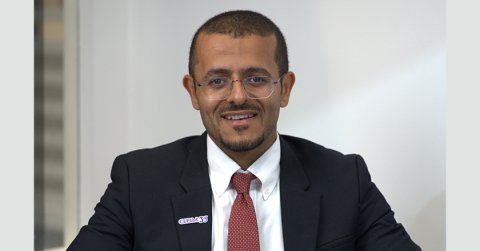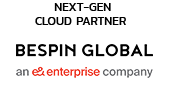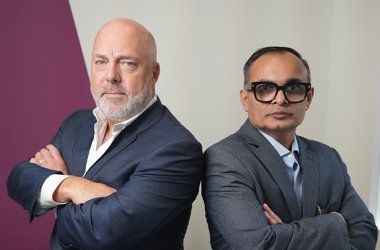
How best to empower talent and foster innovation in a fast-evolving landscape pre-occupied with AI-driven transformation and scalable tech? At GITEX 2025, Mark Forker spoke to Feras Al Majed, General Manager – Human Resources & Communications, GBM, to explore how the company is shaping ‘A More Intelligent Future’ – a future where inclusiveness and transparency are paramount.
What are GBM’s key themes or innovations being showcased at GITEX 2025?
The theme we’re here to demonstrate is ‘Exploring a More Intelligent Future.’ What does that mean? It’s not just about enabling companies with the latest innovations in data, AI, hybrid cloud, security, or automation – it’s also about empowering the talent behind these technologies. Our goal is to help people fully leverage these tools to drive progress and strengthen the economies we serve.
Take AI, for example. What used to be a complex, technical concept has now become mainstream, thanks in part to ChatGPT, which made AI accessible to everyone. Today, people in the workplace are using it more effectively than ever before.
However, that also raises important questions, e.g., how can organisations scale AI securely while ensuring proper governance to prevent issues like bias or hallucinations? That’s where GBM’s approach comes in: we focus on AI that is secure, governed, and scalable.
Scalability is key. Think of it like this: when you buy a car, it eventually becomes outdated, but with technology, we’re working to make scaling seamless and agile. Instead of needing a full system overhaul every few years, we’re helping businesses expand easily through flexible, subscription-based models. As we shift from a hardware-focused approach to hybrid cloud solutions, our clients can store some data on-premises and some in the cloud, giving them real-time access, faster updates, and the ability to scale instantly when needed.
What sets GBM apart is our experience. We’ve been in the region for over 35 years. We combine global standards with local roots, and that’s what truly differentiates us.
Localisation is at the heart of what we do. Our key clients span sectors like banking, government, healthcare, infrastructure, oil and gas, and SMEs. While much of the world’s technology is developed in the West, we’re proud to be developing, customising, and personalising solutions right here in the region. This allows the Middle East to become an early adopter of AI, not just an importer of innovation.
Making technology accessible is where empowerment really happens. When we talk about transformation, especially in a rapidly evolving field like technology, it’s vital to consider the people behind the screens – the citizens, the expats, and the operators who deliver services.
Ultimately, technology should make their work easier and more meaningful. Customers today expect intuitive solutions; tools that work as seamlessly as their smartphones, without the need for constant support or intervention.
So, our focus is twofold: advancing technology and empowering people. That’s what ‘Exploring a More Intelligent Future’ is all about: using innovation to enhance lives, build sustainable economies, and accelerate growth for everyone.
The tech industry is rapidly transforming due to innovation and AI-led manufacture. How is GBM rethinking its workspace strategy to attract, retain and upskill top talent, especially in such a competitive market?
We’ve truly been early adopters of AI, and over time, we’ve seen many iterations in how we use it across the workplace. COVID-19, of course, brought unique challenges – many organisations were forced to rely entirely on technology to manage their day-to-day operations. They had no choice. Now, as we’ve moved beyond that period, the focus has shifted to how we use technology to enhance outcomes and elevate what we call ‘the employee experience’. Let me share a few examples of how we’ve done this, because that’s what allows us to maintain local relevance while meeting global standards.
We’ve embraced e-learning, ensuring that education doesn’t just happen in a classroom, at a conference, or through books; it’s available anytime, anywhere. Through platforms like LinkedIn Learning, as well as our own internally developed platform built on Disperse, employees have access to the latest, most relevant content. Learning is now continuous and bite-sized; it’s no longer a once-a-year event. This approach helps employees learn, unlearn, and relearn quickly, empowering them to adapt and grow with technology.
Technology has also transformed how we attract and build diverse teams. We’re now able to access talent in new and more inclusive ways, far beyond traditional job postings or agencies. In a market like the UAE, where over 200 nationalities coexist, we’ve been able to tap into an incredibly diverse talent pool. And this isn’t just about diversity and inclusion – it makes strong business sense. A more diverse workforce enhances creativity, retention, and overall performance.
Retaining top talent is just as critical as attracting it. While some turnover is natural, our goal is to create an environment where continuous growth, lifelong learning, and technological enablement make employees’ lives easier. Technology allows for flexibility: employees can work, learn, and stay connected from anywhere, which directly supports work-life balance and helps reduce isolation.
We’re also leveraging digital tools to promote holistic wellbeing, and that’s not just for employees, but for their families too. From regular online webinars about physical, mental, and financial health, to accessible wellness programs, we’re able to reach well beyond our 1,500 employees – extending support to their dependents as well. That’s powerful, because wellbeing becomes a shared journey within the household.
Ultimately, technology is helping us go beyond simply offering software, hardware, or security solutions. We’re now using it to share knowledge, empowering both our people and our customers to grow, stay healthy, and stay connected in a rapidly evolving world.
In your view, how can marketing and communications play a strategic role in supporting technology companies’ growth and innovation goals, particularly as they navigate disruptive technologies like AI and cloud computing?
AI and other disruptive technologies – like cloud computing – have created a sense of apprehension in the market. Our goal in marketing is to simplify the message, showcase real success stories, and demonstrate how adoption can be both safe and transformative.
We do this by sharing tangible use cases with our customers, highlighting our own internal adoption, and working closely with our ecosystem partners to amplify that message. We want to show that when used correctly, AI is not something to fear. Many concerns, such as job loss or data integrity, are valid, but through real-world examples, we’re showing that AI can be scaled responsibly and securely.
In marketing, we bring this to life through strategic storytelling. We use real customer journeys to demonstrate how AI is driving measurable outcomes. Internally, we ensure our teams are continuously upskilled so they can communicate effectively – not only with CIOs and IT leaders but also with end-users. Because at the end of the day, the success of any solution depends on the comfort and confidence of the person using it.
For example, if a bank launches an AI-driven solution, it’s only successful if customers – like you and me – trust it. That means feeling confident that personal data is secure, that transactions are protected through tools like OTP verification, and that privacy isn’t compromised. Without robust security, scalability means very little.
That’s why our marketing team works proactively with our partners to highlight these safeguards – across social media, print, digital channels, and through human-centred stories. We deliberately feature non-technical voices – everyday people talking about technology in relatable ways – because accessibility is key.
Technology shouldn’t just serve a few. It must be democratised, secure, and scalable. That’s the core of the message we strive to communicate every day.
Technology like AI is changing how HR and communications operate. How is GBM integrating AI tools to enhance employee experience and engagement?
We’ve started integrating AI across several key areas of our organisation. For instance, when it comes to supporting our employees, we’re using AI to manage routine queries, so they don’t have to wait for a human response. Our AI chatbots provide quick, accurate answers to common questions, automating repetitive processes that once consumed valuable time. Tasks that used to take days, like issuing a salary certificate, can now be completed in a single day using digital signatures and smart automation. This allows us to leverage technology to speed up routine workflows and focus human attention where it truly matters.
On the learning side, AI is enabling personalised and on-demand development. Everyone’s career journey is different; there’s no one-size-fits-all approach. AI helps us customise learning paths, so employees can access exactly what they need, when they need it.
People today expect the same level of flexibility in learning as they do in entertainment. You want to choose what to watch (or in this case, what to learn) on demand. Whether it’s marketing, HR, or business management, employees can now learn at their own pace, in the format that suits them best – be it a podcast, an article, or a video session. Not everyone learns effectively in a two-hour lecture. Some prefer bite-sized, 15-minute sessions that fit into their day. AI makes this kind of adaptive, accessible learning possible.
Beyond learning, our broader objective is to attract, retain, and engage talent while keeping them continuously inspired by lifelong learning. We’re creating a culture that values curiosity, growth, and wellbeing.
AI also allows us to automate repetitive administrative tasks, freeing our people to focus on what truly requires human empathy and creativity. Conversations about personal challenges, team dynamics, or professional growth can’t be outsourced to machines. Those remain fundamentally human interactions.
We’re also extending this approach to our wider ecosystem, working with schools, universities, and partners to ensure they are embracing these technologies. The old model of competition is evolving into one of collaboration. With open-source platforms and shared innovation, everyone benefits as we collectively elevate both internal and external talent.
At GBM, our core vision is to help shape an intelligent, agile future – one that’s secure, scalable, and grounded in strong governance. Because without governance and responsible adoption, we risk losing the very advantages that AI and technology promise.
That’s the essence of what drives us: leveraging AI not just for efficiency, but to empower people, strengthen ecosystems, and build a smarter, more resilient economy.
Image Credit: GBM





